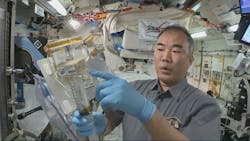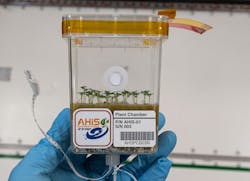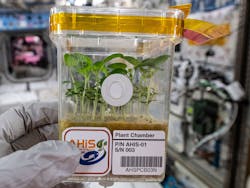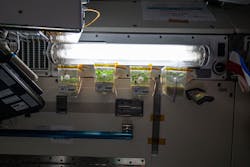Regular readers of LEDs Magazine will know that every so often we like to peer about 220 miles skyward for a peek at what's going on with lighting — usually horticultural lighting — on the International Space Station (ISS).
When we last looked, we spotted US astronaut Kate Rubins tending to radishes growing under the spectrally tuned LEDs in the ISS' Advanced Plant Habitat.
That was some four months ago. So up we glanced again today.
While on every previous occasion we found plants growing under some form of solid-state lighting (check out the links in the story referenced above), what stood out today was an experiment using “just regular lighting,” as Japanese astronaut Soichi Noguchi explained in a video posted on a web page for the Japan Aerospace Exploration Agency (JAXA), Japan's NASA-like outfit.
The project within the ISS' Japanese-run Kibo Laboratory is examining how herbs grow in microgravity. Like all ISS horticultural projects, the idea is to better understand how to cultivate crops in space to support humans on longer and farther expeditions, such as to Mars. The various projects are examining variables including light, nutrition, growth medium, and water.
For a month, astronaut Noguchi grew basil hydroponically. His work is part of a broader initiative called the Asian Herb in Space program, involving Japan, Malaysia, and 10 other countries working on Earth and in space.
On Feb. 16, Noguchi injected water into four small, enclosed, transparent glass chambers which already contained basil seeds.
“We'll put some light on top of it, and see how it grows for the next thirty days,” he says in the Day 1 video.
What sort of light?
“We use the Space Station General Lighting Assembly (GLA),” Noguchi explains.
Oh, really, is that a fancy set of spectrally variable LEDs?
Well, no. “It's just regular light,” Noguchi notes, as the camera shows what appears to be fluorescent tubes.
To help the basil along, Noguchi added a photosynthetic film on top of the chamber.
To the untrained eye, the results look impressive, as evidenced by the Day 10 and Day 21 photos (above) provided by JAXA on Feb. 26 and Mar. 9, respectively. JAXA has not yet publicly provided a Day 30 account from Mar. 18.
According to NASA, the chambers will go into -80°C storage in the ISS' Minus Eighty Laboratory Freezer for ISS (MELFI) before heading back to Earth at -95°C on a SpaceX Dragon cargo vehicle.
In addition to Japan and Malaysia, participants in Asian Herb in Space include Australia, Bangladesh, Indonesia, Nepal, New Zealand, Singapore, Taiwan, Thailand, the UAE, and Vietnam.
MARK HALPER is a contributing editor for LEDs Magazine, and an energy, technology, and business journalist ([email protected]).
For up-to-the-minute LED and SSL updates, why not follow us on Twitter? You’ll find curated content and commentary, as well as information on industry events, webcasts, and surveys on our LinkedIn Company Page and our Facebook page.









